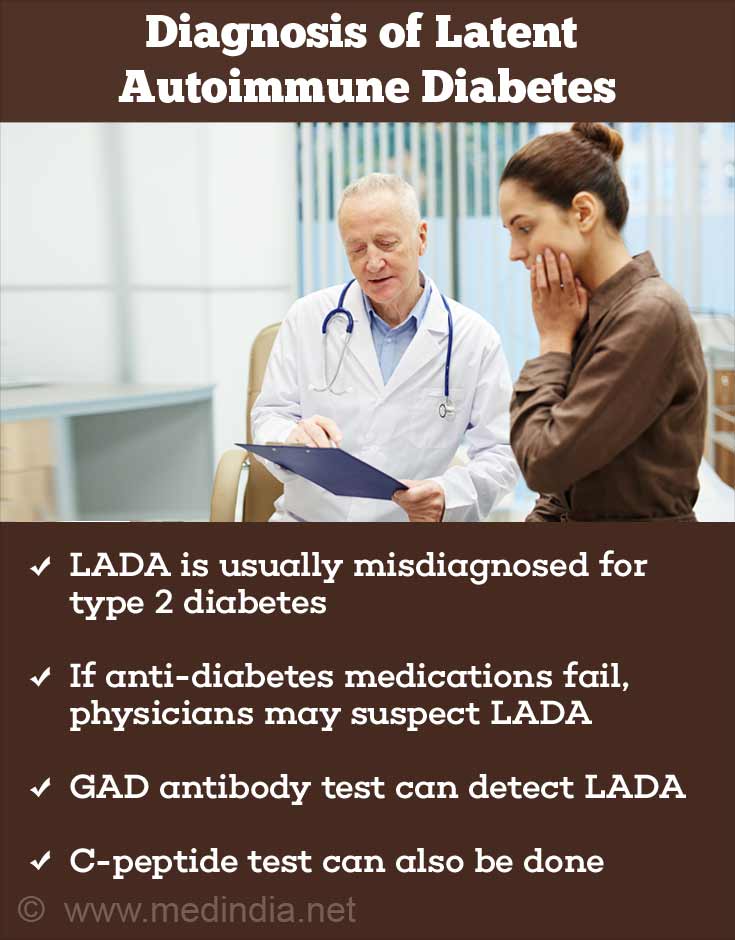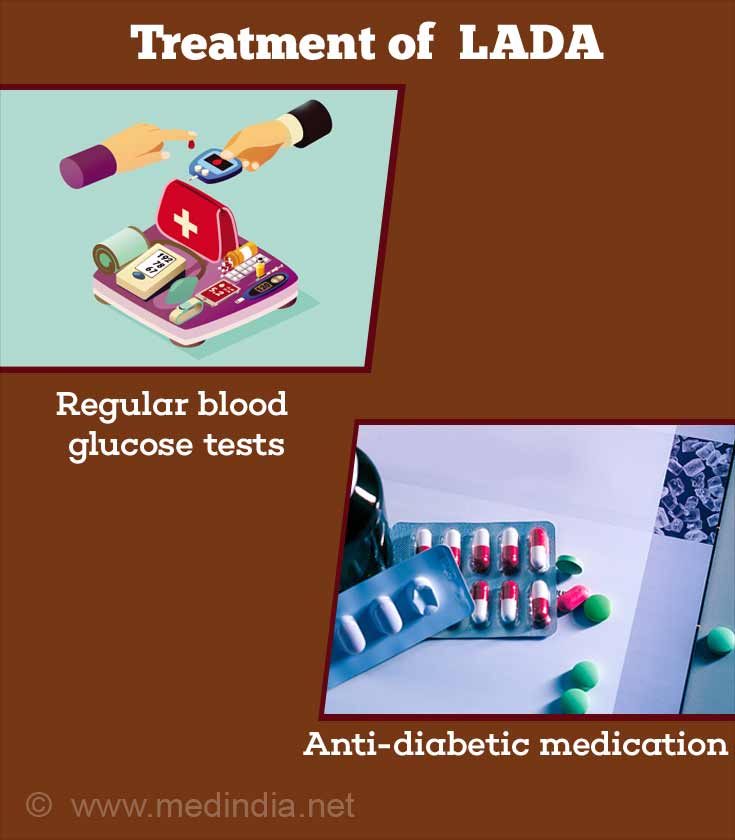- Diabetes LADA - (https://www.diabetes.co.uk/diabetes_lada.html)
- LADA, or Type 1.5 Diabetes - (http://www.diabetesforecast.org/2010/may/the-other-diabetes-lada-or-type-1-5.html)
What is Latent Autoimmune Diabetes?
Latent Autoimmune Diabetes of Adulthood (sometimes referred to as type 1.5 diabetes) is a form of autoimmune type 1 diabetes in which body’s immune system attacks and destroys the insulin producing cells in the islets of the pancreas.
The definition provided by Prof. David Leslie, Principle Investigator of Action LADA, in Europe is as follows -
"LADA is defined as initially non-insulin dependent diabetes diagnosed in people aged 30-50 years, but with antibodies to GAD - glutamic acid decarboxylase."
Normally autoimmune type 1 diabetes is diagnosed in childhood or young adults and rather quickly, sometimes within a matter of days. However, LADA develops more gradually, often over a period of months to years and therefore patients first present when they are in their thirties. Physicians often rule out Type 1 diabetes because of the age factor and misdiagnose it as type 2 adult onset diabetes.
Many scientists believe LADA, is a subtype of type 1 diabetes. Others believe diabetes develops as a continuum, with LADA falling between type 1 and type 2 diabetes. For this reason LADA is also known as type 1.5 diabetes.
Epidemiology of LADA
Statistics indicate that between 6-50% of all persons diagnosed with type 2 diabetes might actually have LADA. This figure accounts for an estimated 5–10% of the total diabetes population in the U.S. or, a whopping 3.5 million persons with LADA. Persons with LADA typically have a normal BMI or may be underweight due to weight loss prior to diagnosis. Some people with LADA, however, may be overweight to mildly obese.
Interestingly, some people having LADA do in fact have a family history of type 2 diabetes.
Facts and Statistics of Latent Autoimmune Diabetes
- Latent Autoimmune Diabetes is actually not latent. It only does not become evident right away
- For LADA to be diagnosed there should be evidence of an autoimmune etiology
- Most persons diagnosed with LADA are over 30 years
- Many persons with LADA are misdiagnosed as having type 2 diabetes because the pancreas still produces some insulin. They present with similar symptoms such as excessive thirst, frequent urination, high blood sugar levels and blurred vision.
- LADA can be conservatively managed with diet and lifestyle modifications initially but eventually insulin will be needed, similar to type 1 diabetes
- LADA may be difficult to diagnose as there are no definite recommendations on screening for the condition. Nevertheless there are certain markers and symptoms to be considered
- LADA may be suspected when a patient diagnosed with type 2 diabetes does not respond to oral antidiabetic agents; additional confirmation requires presence of antibodies in blood
- Currently there are no definitely established treatment guidelines although research suggests that small doses of insulin soon after diagnosis may help
How LADA was Discovered - History
Like many scientific discoveries, doctors stumbled upon the LADA phenomenon quite accidentally back in the 1970s. They were testing methods to detect proteins called autoantibodies in the blood of people with type 1 diabetes. The presence of these proteins suggested attack by one's own immune system. The new test was successful and for the first time confirmed that type 1 is an autoimmune disease where the insulin producing cells of the pancreatic islets are destroyed by the body’s own immune system.
As part of their study, the scientists also looked for similar autoantibodies in the general population and in patients with type 2 diabetes (which is not an autoimmune disease).
These autoantibodies were virtually absent in the general population, but they were present, to the scientists' surprise, in about 10 percent of persons diagnosed with type 2.
This suggested that there was a subcategory of patients who could now be diagnosed as having LADA instead, despite there being no obvious difference in their symptoms from those of people with type 2 diabetes.
LADA however, was not officially recognized until 1993, when it was used to describe slow-onset type 1 autoimmune diabetes occurring in adults. This followed the discovery that GAD autoantibodies were a feature of type 1 diabetes and not type 2 diabetes.
Types of Diabetes
Clinically diabetes mellitus can be broadly subdivided into the following types
| Diabetes Type | Features |
| Type 1 | Primarily a result of pancreatic beta cell destruction with resulting insulin deficiency. Autoimmune process but etiology unclear. Ketoacidosis more common |
| Type 2 | Predominantly insulin resistance and relative insulin deficiency. Ketoacidosis uncommon |
| Gestational | Glucose intolerance first recognized during pregnancy |
| Others | Specific forms of diabetes either genetically defined, due to other diseases, drug induced |
What are the Symptoms & Signs of Latent Autoimmune Diabetes ?
The initial symptoms of LADA include:
- Feeling exhausted all the time, particularly tired after meals
- Confusion and light-headedness
- Feeling hungry after meals
As LADA evolves, a person’s ability to produce insulin will gradually decrease resulting in symptoms such as:
- Blurred vision
- Tingling and painful hands and feet
- Frequent drinking of water (polydipsia)
- Frequent passing of urine (polyuria)
It is important to catch the symptoms as early as possible because a delay in diagnosis increases the risk of developing diabetes complications.
Having burning and painful sensation of extremities can be a sign of neuropathy (nerve disease), and if this symptom occurs regularly and in association with other symptoms, it is advisable to seek immediate medical attention.

What are the Consequences / Complications of Latent Autoimmune Diabetes?
Short-term Complication of LADA
Diabetic ketoacidosis - Particularly once the pancreas has lost much of its ability to form insulin.
People with LADA should know about the signs and symptoms of ketoacidosis and to self-test for ketones if needed.
Long Term Complications
Long term complications of LADA will be similar to the those in persons with type 1 and type 2 diabetes.
The various long term complications of LADA include the following
- Heart disease and stroke
- Nephropathy (kidney disease)
- Diabetic Retinopathy (Eye disease)
- Neuropathy (nerve disease)
- Foot problems
How do you Diagnose Latent Autoimmune Diabetes?
- Very often a diagnosis of LADA is not made in the first instance. The person will be diagnosed as having type 2 diabetes by means of the usual methods (urine and blood sugar testing)
- Following the diagnosis of type 2 diabetes the physician may have reason to suspect that the initial diagnosis of type 2 diabetes may be inaccurate and need to rule out LADA.
- Confirming the presence of LADA is done by checking for the presence of elevated levels of pancreatic autoantibodies in patients recently diagnosed with diabetes but do not require insulin or not responding to oral antidiabetic drugs. A GAD Antibody test is performed to measure the presence of these autoantibodies. These antibodies not only diagnose presence of LADA, but can also can predict the rate of progression towards becoming insulin dependent.
- Another test that can be done is a C-peptide test. However, C-peptide tests may not always be conclusive in persons with early stage LADA diabetes.

Clinical Features to Suggest LADA Rather Than Type 2 Diabetes
- Absence of features of
metabolic syndrome such as obesity, elevated blood pressure and cholesterol levels - Uncontrolled hyperglycemia in spite of using oral antidiabetic agents
- Occurrence of other autoimmune conditions (including Graves' disease and Anemia)
How can you Treat Latent Autoimmune Diabetes?
1. Management of type 1 diabetes/LADA is administration of exogenous insulin to
- Control glucose levels Prevent further damage and destruction of residual beta cells
- Decrease the risk of diabetic complications, and prevent death from diabetic ketoacidosis (DKA).
Although LADA may seem to initially respond to similar treatment (lifestyle and medications) as type 2 diabetes, people with LADA will eventually become insulin-dependent as the conservative measures or oral agents fail to reduce or prevent the progression of the disease.
In some cases, insulin therapy may be postponed. However, research evidence suggests that commencing insulin treatment soon after a diagnosis of LADA will help to better preserve the pancreas’ function of insulin production.
Regular blood glucose testing is advised for people with LADA similar to that recommended for people with type 1 diabetes. Therefore it is advisable to test blood sugar levels before each meal and before going to bed.

How can you Prevent Latent Autoimmune Diabetes?
There is no known way of preventing LADA type 1 diabetes though some scientists believe it could be halted at a very early stage if a diagnosis is made before the immune system destroys the insulin producing cells of the pancreas.








